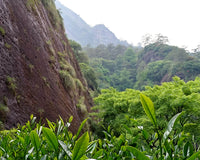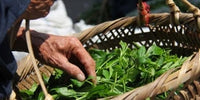Jasmine tea is characterised by the naturally sweet tea flavour as well as the fragrance of jasmine flowers.
Quality Jasmine teas are made by scenting tea leaves with fresh flower buds. Baked green tea is often the preferred base tea selected for jasmine tea scenting, though there are many very enjoyable black jasmine teas available.
To enjoy the tea is to enjoy it's fragrance and the calming combination of tea and jasmine. Jasmine has been long associated with relaxation and is common in aromatherapy. In China, Jasmine teas and flower teas tend to be more popular among tea lovers in the north of China. It is said that the harder water is more suited to these types of teas.
Jasmine tea is usually prepared by placing the leaf directly in to a covered porcelain cup or other kinds of cup/mug with a lid in order to keep its aroma. Most jasmine teas can be infused multiple times making them very convenient and cost effective. When enjoying jasmine tea, one can smell not only the fragrance of the tea liquor, but also the fragrance on the lid.
What Is Jasmine Tea?
Jasmine tea is created by combining the natural aromas of jasmine flower with tea - usually green tea, white tea or black tea.
Although any area that grows tea and has access to jasmine flower could potentially produce it, Fujian Province has become best known for jasmine tea. It is there the craft of creating jasmine pearl teas and jasmine blooming teas has made its home. Award-winning jasmine tea (like ours) comes when the best combination of ingredients and manual skill intersect.
How Is Jasmine Tea Made?
Wan Ling Tea House jasmine teas come in different forms. Pearl teas are typically green tea or white tea leaves rolled into a spherical shape and scented with jasmine. Blooming teas combine green teas and can contain actual flowers enfolded within a bundle of green tea leaves.
For jasmine pearls, the most familiar practice involves harvesting jasmine flowers during the day when the flowers are closed. The jasmine and the tea may be placed together on trays in an enclosed space. When the jasmine flowers open, the tea absorbs the scent. This process may be repeated several times with fresh flowers, and each scenting may last several hours.
When done well, the jasmine aroma is rich but not cloying. Superior jasmine teas will have a more balanced fragrance that is more even in intensity from the moment the tea touches your tongue on through to the aftertaste.
Jasmine Pearls
Popular types of jasmine tea include green tea based Xiao Long Zhu 小龙珠 tea pearls or dragon pearls, which come in a range of grades of which the quality varies tremendously. Typically you can distinguish the grades when dry from the proportion of jasmine flower to green tea; the size of the pearl - small being a sign of quality; the colour of the green tea, with a paler, softer green being preferred. When preparing the jasmine tea you will notice higher grade teas will be a much paler and vibrant green often with fine hairs. As with all good teas the leave should consist of no more than two leaves and a bud, with limited amounts of stalk.
Jasmine Blooming Teas
Jasmine blooming teas go even further. After green tea leaves are scented with jasmine, skilled artisans carefully bundle and sew tea leaves and dehydrated flowers together into beautiful designs. Once the designs are created, they are tucked within the green tea leaves. The green tea leaves are bundled around the flower and dried to preserve the leaves and maintain the shape of the bundle.


Blooming Jasmine Balls
Very popular are jasmine blooming teas otherwise known as blossoming teas, flowering tea, display tea or art tea amongst many other names. These intriguing hand made teas capture the imagination and with a multitude of different designs you never quite know what you might discover.
When preparing the blooming teas, it is best to find a tall glass that is heat resistant, ideally with a stem or a tall bodied glass teapot such as our Blooming tea glass teapot. Fill the glass with near boiling water and drop the tea in. We don't want spoil the surprise so we won't mention what happens! After 3-4 minutes, decant the tea liquor in a jug and serve, you can refill the glass with hot water to produce additional infusions that can be drunk whilst continuing to enjoy the show. These teas can usually be infused 3-4 times (or more) depending on personal preferences. Once you have finished drinking the tea, pour off all the hot water and then refill with cold water so you can enjoy the visual feast without the tea colouring the water.
As most jasmine teas are blended with tea leaf i.e. Camellia Sinensis they do contain caffeine. Due to the terroir nature i..e in the influence of soil, climate etc., of tea then it is very difficult to exactly say how much caffeine is each type of tea as it will vary season to season, year to year and tea farm to tea farm. If you are sensitive to caffeine it is best to avoid teas in the evening or to look at the many wonderful tisanes available.
Quality of Jasmine Teas
When choosing a jasmine tea, there are a few ways to determine their degree of quality.
For jasmine pearls, note the size and color. Smaller pearls usually indicate younger, more delicate tea leaves. Larger, darker color pearls are made with older, coarser leaves. Once the leaves have been steeped and softened, these pearls should reveal a set of 2 leaves and 1 bud. With quality jasmine teas, a greater number of silver tips is more readily apparent.
The color of the tea leaves is also a factor. Superior quality spring green tea and white tea are usually harvested in March - April, while jasmine flowers are usually collected in May - June. Tea leaves may be partially processed and set aside until the jasmine flower is ready. As the tea waits, it may need to be re-dried, or time itself may change the color of the leaves if not stored well. Fresher, younger leaves are generally paler green with silvery-white buds.
Enjoying Jasmine Tea
To make the most of jasmine teas, be sure to keep these tips in mind:
1. For blooming teas, a tall drinking glass or deeper glass teapot will give the blooming tea the space to expand and give you the ability to see the blooming tea unfold. If you use a drinking glass, try to find one with a handle. The glass may get very hot to handle. With some blooming teas, it may be advantageous to decant the initial hot liquid for drinking, and then replace with cooler water to keep the tea liquor from becoming too dark and too strong.
2. Jasmine pearls are even easier. You can easily steep your ideal cup of tea each time because you can conveniently count the number of pearls to drop in your mug or tea cup. Simply re-steep by adding with hot water. This method offers excellent value by allowing 25 servings of 2 grams for each 50 gram box. Even more value is created through the multiple infusions available from each serving.
3. Take the time to enjoy the aroma. With a quality jasmine tea, you'll be glad you did. Poorer, artificially flavoured jasmine teas usually have strong aromas in the first steeping that disappear. That won't happen with Wan Ling Tea House jasmine teas.
"Nothing more refreshing."
Quote by Glynn Christian, on our Grade A Jasmine Tea Pearls














